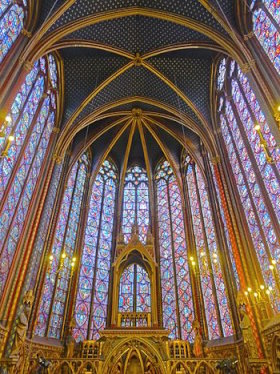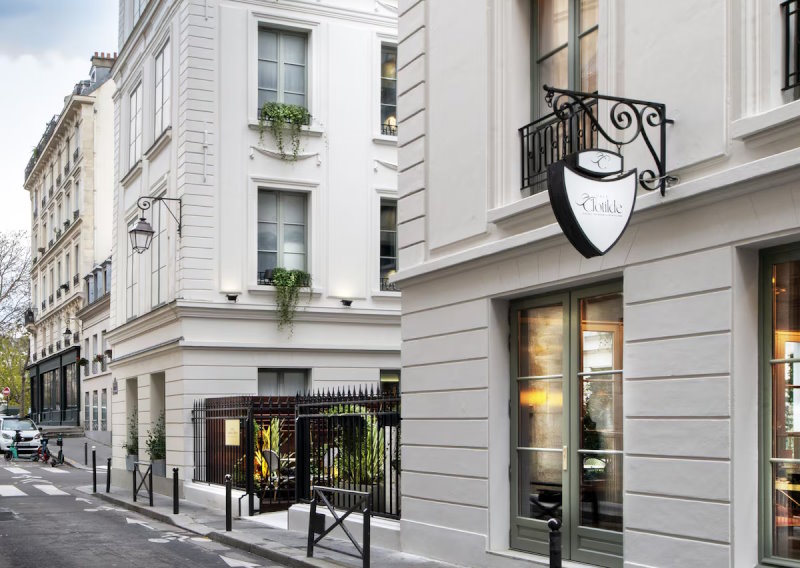Sainte-Chapelle in Paris. History. Visits

Sainte-Chapelle, a Unesco world heritage site, was built in Paris by King Saint-Louis from 1238 to 1246to host the Christ' Crown of Thorns. Close to Notre-Dame Cathedral in Ile de la Cité, Sainte-Chapelle, a Gothic masterpiece, has 15 spectacular stained glass windows. Concerts are performed in Sainte-Chapelle. Churches in Paris. Paris monuments.
Sainte-Chapelle facts
Sainte-Chapelle is a Paris' jewels. This 13th century inspired church features fifteen wonderful stained glass windows that should be seen from the inside.
Sainte Chapelle was built in 1246 by King Saint Louis to house the relics of Jesus Christ's crucifixion, including the Crown of Thorns and a fragment of the Holy Cross, now in Notre-Dame. Together with La Conciergerie, Sainte-Chapelle was part of the Palais de la Cité, the first royal palace.
We recommend you to visit Sainte-Chapelle, close to Notre-Dame Cathedral. To avoid the long queues, go there at opening time. Avoid weekends.

Sainte-Chapelle is a famous church in Paris
Sainte-Chapelle visits
Sainte-Chapelle is located 10, boulevard du Palais 75001 Paris in Ile de la Cité. Locate Sainte-Chapelle on Paris map.
Paris metro: Cité station on line 4, Saint Michel on RER B.
Paris 75001 France
Attending a concert in Sainte-Chapelle is a memorable experience. Check program of concerts in Sainte-Chapelle (March to November).
Entrance fee: 13 euros.

Sainte-Chapelle stainglasses are unique
Sainte-Chapelle hours
From January 2 to March 31, open every day 9am to 5pm.
From April 1 to September 30, open every day 9am to 7pm.
From October 1 to December 31, open every day 9am to 5pm.
Closing days: January 1, May 1 and December 25.
Timeslot reservation is mandatory.
Sainte Chapelle hotel
Hotel Melia Notre Dame is one of the best hotels near Sainte Chapelle. Located in a quiet street, 500 m from Sainte Chapelle, it provides free Wi-Fi. The air-conditioned guest rooms have private bathrooms and internet access. Some have views of Notre Dame Cathedral. Room service is available in the evenings, with gastronomic French specialties.
Paris 75005 France

Hotel Melia Paris Notre-Dame
Stay in top Sainte Chapelle hotel

Sainte-Chapelle history
Sainte-Chapelle is a Gothic chapel, built in Ile de la Cité, the Paris Island, in 1246 during the Middle Ages.
King Saint Louis bought the Christ's Crown of Thorns from Constantinople, nowadays Istanbul. The King commissioned Sainte-Chapelle as the crown's shrine in his Cité Palace, nowadays the Conciergerie. In 1806, the Crown was transfered to Notre-Dame Cathedral where it could be seen every first Friday of the month.

Sainte-Chapelle was Crown of Thorns' shrine
Sainte-Chapelle detailed history
Sainte Chapelle was a reliquary built to house the relics of the Crucifixion.
In 1239, Saint Louis bought the crown of thorns from Venetian merchants for 135,000 Pounds. Fragments of the Holy Cross were bought from Baudoin II, king of Jerusalem in 1241. Saint Louis did not want these holy relics to be scattered. Such precious relics deserved to be sheltered in a special place. Hence, Saint Louis chose to have a church built inside the Royal Palace in Ile de la Cité in order to emphasize the close relationship between the Holy Relics and the monarchy. Indeed, building Sainte Chapelle was not only an act of faith; it was also a political deed.
The church, which has two levels, was consecrated on April 26th, 1248, so it is assumed that Sainte Chapelle was finished at this time. The starting date, however, is still unknown, as is the name of the master mason. The ground level was dedicated to parish services and the relics were kept on the upper level, which was directly connected to the main King council room. This arrangement was probably inspired by Charlemagne's palace in Aachen.
Other buildings were later added to Sainte Chapelle. An annex built on the northern side was destroyed in 1777, and there was a staircase which enabled people to reach the upper level on the southern side. From that time on, a choir screen was added to isolate clergymen and upper class people from common people. Sainte Chapelle suffered from several fires (1630, 1777) and one flood. Nor did the French Revolution spare it: the outside ornamentation was damaged, especially the spire, whose fleurs-de-lis were considered a symbol of the French monarchy. Then, during the First Empire, the upper chapel was used as an archive warehouse, which led to severe damage and the stained glass windows were dismantled. Restorations were made in the second part of the 19th century, led by the architects Félix Duban (from 1836 to 1848), Jean-Baptiste Lassus (from 1848 to 1857) and Emile Boeswillwald. Viollet-le-Duc occasionally cooporated with them without ever leading the project. The remains of the above mentioned staircase were destroyed (1849) and a new spire was built (1853). In 1857 restoration of the ornamentation was completeted.
Sainte Chapelle and the Palais de la Cité detailed history
Sainte Chapelle was part of the Palais de la Cité, the residence of the kings of France for four centuries. Transformed into a courthouse, it became the Palais de Justice, the nerve center of the French judicial administration for a thousand years. The tallest building in Île de la Cité, the Palais de la Cité occupied almost a third of the island.

La Conciergerie and Palais de la Cité in the Middle Ages
After the conquest of the Gaul by the Romans in 52 BC, a pagan temple was built to the east of Ile de la Cité, where Notre-Dame is located today, while at the west end was built a palace for the governor of Lutece, sent from Rome. The Roman emperor Julien settled there in 357, followed by Valentinian I a few years later. At the fall of the Roman Empire in 476, Gaul was invaded by the Franks, who conquered it in 486. At that time, Paris was not a big capital, not even a big city. The Palais de la Cité became the Parisian residence of the Merovingian kings when they were passing through the city.
At the end of the 10th century, Robert II le Pieux, son of Hugues Capet and second Capetian king, was the first sovereign to settle in the Palais de la Cité permanently. He had the palace rebuilt and the King's Hall became the administrative center of the kingdom. He also built the Saint-Nicolas chapel. To the west of the palace was the king's garden, at the downstream point of the Ile de la Cité. Louis VI le Gros built a tower during the first half of the 12th century which took the name of "Grosse Tour". His son, Louis VII, continued the development of the royal home. In 1163 construction began on Notre-Dame, which lasted nearly two centuries. Philippe Auguste, son of Louis VII, was the first great builder of Paris. The streets of Paris, once paved by the Romans, were covered with a millennium of mud. The king paved the streets around the palace but it is for the enclosure of Philippe Auguste that he is known today. Begun in 1190 and completed in 1215, this 5,100-meter wall encompassed the capital for almost two hundred years. Beyond the western limits of the city was built a keep called the Louvre to protect Paris from a possible English attack. The Palais de la Cité thus lost its role as a fortress.
Under Saint-Louis, the palace experienced significant growth. Having bought the holy relics from Baudouin II in Constantinople, Saint Louis had the Saint-Nicolas chapel razed and had the Sainte-Chapelle built between 1242 and 1248 to house them. The king paid 135,000 pounds for tournaments (about three million euros) for the relics, 100,000 pounds for the manufacture of the silver hunting inlaid with precious stones, intended to receive the relics, and only 40,000 pounds for the construction of the Sainte-Chapelle. The king built a direct access from his apartments to the Sainte-Chapelle. Saint Louis also erected the Reformers' tower, which served as a torture chamber and was later renamed the “Bonbec tower”. Son of Louis IX, Philippe III le Hardi continued the work undertaken by his father and had the palace extended beyond its Gallo-Roman limits. But it was his son Philippe IV le Bel who accomplished the greatest works of the palace since its construction. The King's Hall of Robert the Pious was demolished to make way for the Great Hall. This immense space was decorated with forty-two statues of kings, from the mythical Merovingian king Pharamond to Philippe le Bel. At 63 meters long by 27 meters wide and 8.5 meters high, this hall was one of the largest in Europe. The Great Hall served as the king's bed of justice (a session of Parliament to approve the royal edicts, where the king was lying on a bed of cushions under a canopy) and reception room. The king's guests ate around the long black marble table, a piece of which is on display today in the Salle des Gens d'Armes. The Great Lower Room, or the Hall of Arms, named Salle des Gens d'Armes today, served as a refectory for the two thousand employees. It has survived the ravages of time and the many modifications to the building, today it is the entrance hall of the Conciergerie. To the north, "chambers on the water" were built, including the Grand’Chambre, where the Parliament of Paris sat. Philippe le Bel also reinforced the towers to the north with, to the east of the Bonbec tower, the Argent tower and the Caesar tower. The three sons of Philippe le Bel reigned successively under the names of Louis X le Hutin, Philippe V le Long and Charles IV le Bel. When the latter died without a male heir, the Capetian dynasty died out and his cousin, Philippe VI, rose to the throne, establishing the Valois dynasty. The son of Philippe VI, Jean II le Bon, continued the work started by his great uncle, Philippe IV. He finished the kitchens north of the Great Lower Hall and built a watchtower at the northeast end of the palace.
Charles V, son of John II, became regent of the kingdom during his father's captivity in London. On February 22, 1358, the provost of the Paris merchants Etienne Marcel, trying to obtain reforms from the dolphin Charles before approving the payment of a ransom to the English, entered the palace with his men, who killed the marshals of Champagne and Normandy. This act ended the four centuries when the city palace played a central role in state affairs. As early as 1360, the dolphin left the Ile de la Cité to settle in more secure residences: the Louvre, the Hôtel Saint-Pol and the Château de Vincennes. He built a new wall on the right bank, called the enclosure of Charles V, as well as the Bastille. The new guardian of the Palace of the City was called the concierge and all the buildings under his charge were now called the Conciergerie. Charles V added to the Conciergerie one of the most beautiful objects in the city, which still adorns the corner of the Boulevard du Palais and the Quai de l'Horloge: in 1370, the watchtower of Jean le Bon was equipped with the first public clock in Paris. The watchtower became the Clock Tower. Although the palace continued to receive royal festivals and to house the Parliament, the place vacated by the royal family was reconverted. In 1381, under Charles VI, the ground floor of the royal dwelling became a prison, receiving the prisoners of the Parliament hitherto kept in the prison of Châtelet. Most of the cells were built in the northern part of the Conciergerie.